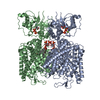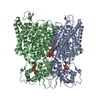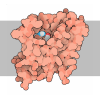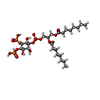[English] 日本語
 Yorodumi
Yorodumi- PDB-8iab: The Arabidopsis CLCa transporter bound with chloride, ATP and PIP2 -
+ Open data
Open data
- Basic information
Basic information
| Entry | Database: PDB / ID: 8iab | |||||||||
|---|---|---|---|---|---|---|---|---|---|---|
| Title | The Arabidopsis CLCa transporter bound with chloride, ATP and PIP2 | |||||||||
 Components Components | Chloride channel protein CLC-a | |||||||||
 Keywords Keywords | MEMBRANE PROTEIN / Transporter / ATP / PIP2 | |||||||||
| Function / homology |  Function and homology information Function and homology informationnitrate transmembrane transporter activity / nitrate transmembrane transport / response to nitrate / voltage-gated chloride channel activity / chloride transport / chloride channel complex Similarity search - Function | |||||||||
| Biological species |  | |||||||||
| Method | ELECTRON MICROSCOPY / single particle reconstruction / cryo EM / Resolution: 2.96 Å | |||||||||
 Authors Authors | Yang, Z. / Zhang, X. / Zhang, P. | |||||||||
| Funding support |  China, 2items China, 2items
| |||||||||
 Citation Citation |  Journal: Nat Commun / Year: 2023 Journal: Nat Commun / Year: 2023Title: Molecular mechanism underlying regulation of Arabidopsis CLCa transporter by nucleotides and phospholipids. Authors: Zhao Yang / Xue Zhang / Shiwei Ye / Jingtao Zheng / Xiaowei Huang / Fang Yu / Zhenguo Chen / Shiqing Cai / Peng Zhang /  Abstract: Chloride channels (CLCs) transport anion across membrane to regulate ion homeostasis and acidification of intracellular organelles, and are divided into anion channels and anion/proton antiporters. ...Chloride channels (CLCs) transport anion across membrane to regulate ion homeostasis and acidification of intracellular organelles, and are divided into anion channels and anion/proton antiporters. Arabidopsis thaliana CLCa (AtCLCa) transporter localizes to the tonoplast which imports NO and to a less extent Cl from cytoplasm. The activity of AtCLCa and many other CLCs is regulated by nucleotides and phospholipids, however, the molecular mechanism remains unclear. Here we determine the cryo-EM structures of AtCLCa bound with NO and Cl, respectively. Both structures are captured in ATP and PI(4,5)P bound conformation. Structural and electrophysiological analyses reveal a previously unidentified N-terminal β-hairpin that is stabilized by ATP binding to block the anion transport pathway, thereby inhibiting the AtCLCa activity. While AMP loses the inhibition capacity due to lack of the β/γ- phosphates required for β-hairpin stabilization. This well explains how AtCLCa senses the ATP/AMP status to regulate the physiological nitrogen-carbon balance. Our data further show that PI(4,5)P or PI(3,5)P binds to the AtCLCa dimer interface and occupies the proton-exit pathway, which may help to understand the inhibition of AtCLCa by phospholipids to facilitate guard cell vacuole acidification and stomatal closure. In a word, our work suggests the regulatory mechanism of AtCLCa by nucleotides and phospholipids under certain physiological scenarios and provides new insights for future study of CLCs. | |||||||||
| History |
|
- Structure visualization
Structure visualization
| Structure viewer | Molecule:  Molmil Molmil Jmol/JSmol Jmol/JSmol |
|---|
- Downloads & links
Downloads & links
- Download
Download
| PDBx/mmCIF format |  8iab.cif.gz 8iab.cif.gz | 250 KB | Display |  PDBx/mmCIF format PDBx/mmCIF format |
|---|---|---|---|---|
| PDB format |  pdb8iab.ent.gz pdb8iab.ent.gz | 201.4 KB | Display |  PDB format PDB format |
| PDBx/mmJSON format |  8iab.json.gz 8iab.json.gz | Tree view |  PDBx/mmJSON format PDBx/mmJSON format | |
| Others |  Other downloads Other downloads |
-Validation report
| Summary document |  8iab_validation.pdf.gz 8iab_validation.pdf.gz | 627 KB | Display |  wwPDB validaton report wwPDB validaton report |
|---|---|---|---|---|
| Full document |  8iab_full_validation.pdf.gz 8iab_full_validation.pdf.gz | 630.7 KB | Display | |
| Data in XML |  8iab_validation.xml.gz 8iab_validation.xml.gz | 27.7 KB | Display | |
| Data in CIF |  8iab_validation.cif.gz 8iab_validation.cif.gz | 41.5 KB | Display | |
| Arichive directory |  https://data.pdbj.org/pub/pdb/validation_reports/ia/8iab https://data.pdbj.org/pub/pdb/validation_reports/ia/8iab ftp://data.pdbj.org/pub/pdb/validation_reports/ia/8iab ftp://data.pdbj.org/pub/pdb/validation_reports/ia/8iab | HTTPS FTP |
-Related structure data
| Related structure data |  35299MC  8iadC M: map data used to model this data C: citing same article ( |
|---|---|
| Similar structure data | Similarity search - Function & homology  F&H Search F&H Search |
- Links
Links
- Assembly
Assembly
| Deposited unit | 
|
|---|---|
| 1 |
|
- Components
Components
| #1: Protein | Mass: 85488.906 Da / Num. of mol.: 2 Source method: isolated from a genetically manipulated source Source: (gene. exp.)   Komagataella pastoris (fungus) / References: UniProt: P92941 Komagataella pastoris (fungus) / References: UniProt: P92941#2: Chemical | #3: Chemical | #4: Chemical | #5: Chemical | ChemComp-CL / Has ligand of interest | N | Has protein modification | Y | |
|---|
-Experimental details
-Experiment
| Experiment | Method: ELECTRON MICROSCOPY |
|---|---|
| EM experiment | Aggregation state: PARTICLE / 3D reconstruction method: single particle reconstruction |
- Sample preparation
Sample preparation
| Component | Name: The Arabidopsis CLCa transporter / Type: COMPLEX / Entity ID: #1 / Source: RECOMBINANT |
|---|---|
| Source (natural) | Organism:  |
| Source (recombinant) | Organism:  Komagataella pastoris (fungus) Komagataella pastoris (fungus) |
| Buffer solution | pH: 8 |
| Specimen | Embedding applied: NO / Shadowing applied: NO / Staining applied: NO / Vitrification applied: YES |
| Vitrification | Cryogen name: ETHANE |
- Electron microscopy imaging
Electron microscopy imaging
| Experimental equipment |  Model: Titan Krios / Image courtesy: FEI Company |
|---|---|
| Microscopy | Model: FEI TITAN KRIOS |
| Electron gun | Electron source:  FIELD EMISSION GUN / Accelerating voltage: 300 kV / Illumination mode: FLOOD BEAM FIELD EMISSION GUN / Accelerating voltage: 300 kV / Illumination mode: FLOOD BEAM |
| Electron lens | Mode: BRIGHT FIELD / Nominal defocus max: 2000 nm / Nominal defocus min: 1000 nm |
| Image recording | Electron dose: 56.3 e/Å2 / Film or detector model: GATAN K3 (6k x 4k) |
- Processing
Processing
| CTF correction | Type: PHASE FLIPPING AND AMPLITUDE CORRECTION |
|---|---|
| 3D reconstruction | Resolution: 2.96 Å / Resolution method: FSC 0.143 CUT-OFF / Num. of particles: 135900 / Symmetry type: POINT |
 Movie
Movie Controller
Controller



 PDBj
PDBj








